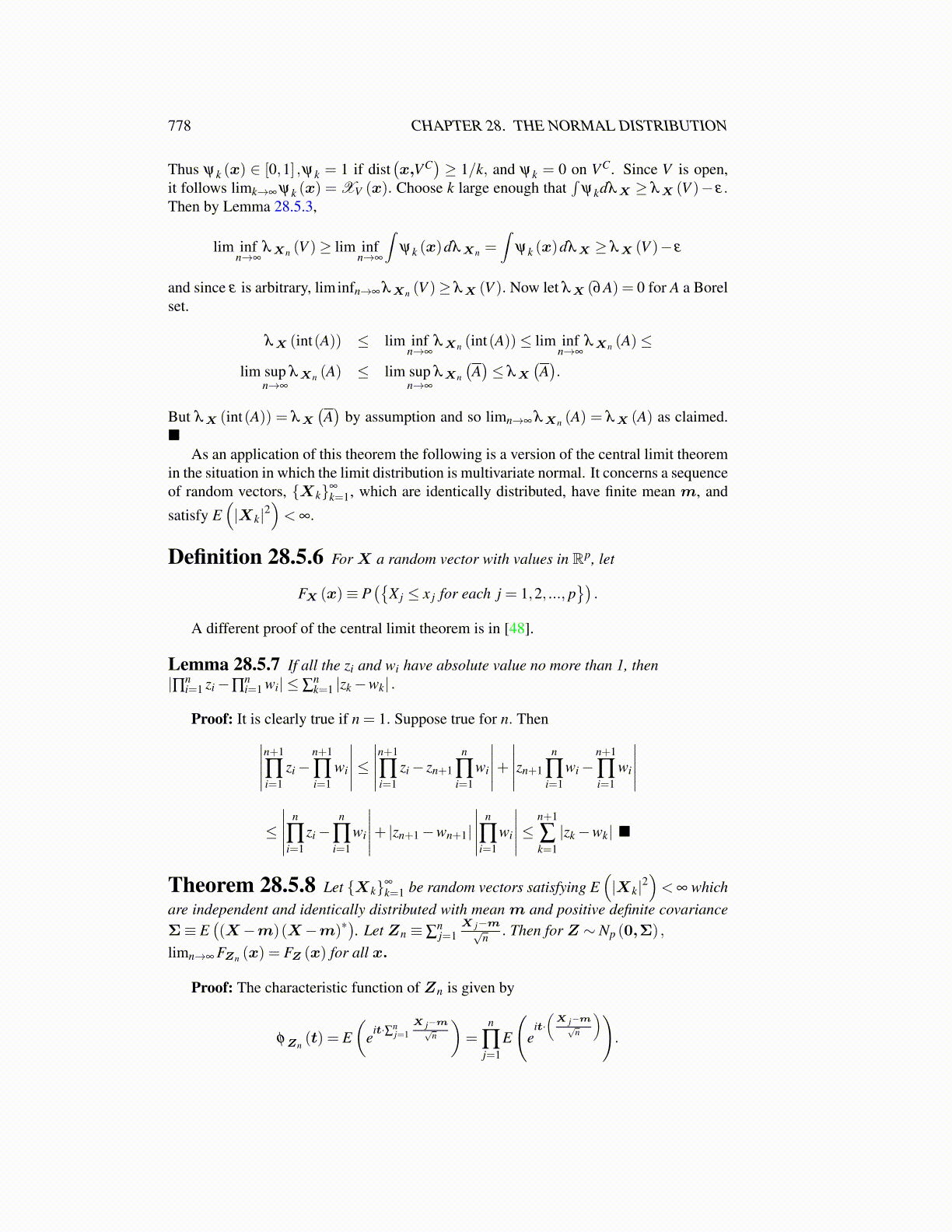
778 CHAPTER 28. THE NORMAL DISTRIBUTION
Thus ψk (x) ∈ [0,1] ,ψk = 1 if dist(x,VC
)≥ 1/k, and ψk = 0 on VC. Since V is open,
it follows limk→∞ ψk (x) = XV (x). Choose k large enough that∫
ψkdλX ≥ λX (V )− ε.Then by Lemma 28.5.3,
lim infn→∞
λXn (V )≥ lim infn→∞
∫ψk (x)dλXn =
∫ψk (x)dλX ≥ λX (V )− ε
and since ε is arbitrary, liminfn→∞ λXn (V )≥ λX (V ). Now let λX (∂A) = 0 for A a Borelset.
λX (int(A)) ≤ lim infn→∞
λXn (int(A))≤ lim infn→∞
λXn (A)≤
lim supn→∞
λXn (A) ≤ lim supn→∞
λXn
(A)≤ λX
(A).
But λX (int(A)) = λX
(A)
by assumption and so limn→∞ λXn (A) = λX (A) as claimed.■
As an application of this theorem the following is a version of the central limit theoremin the situation in which the limit distribution is multivariate normal. It concerns a sequenceof random vectors, {Xk}∞
k=1, which are identically distributed, have finite mean m, and
satisfy E(|Xk|2
)< ∞.
Definition 28.5.6 ForX a random vector with values in Rp, let
FX (x)≡ P({
X j ≤ x j for each j = 1,2, ..., p})
.
A different proof of the central limit theorem is in [48].
Lemma 28.5.7 If all the zi and wi have absolute value no more than 1, then|∏n
i=1 zi−∏ni=1 wi| ≤ ∑
nk=1 |zk−wk| .
Proof: It is clearly true if n = 1. Suppose true for n. Then∣∣∣∣∣n+1
∏i=1
zi−n+1
∏i=1
wi
∣∣∣∣∣≤∣∣∣∣∣n+1
∏i=1
zi− zn+1
n
∏i=1
wi
∣∣∣∣∣+∣∣∣∣∣zn+1
n
∏i=1
wi−n+1
∏i=1
wi
∣∣∣∣∣≤
∣∣∣∣∣ n
∏i=1
zi−n
∏i=1
wi
∣∣∣∣∣+ |zn+1−wn+1|
∣∣∣∣∣ n
∏i=1
wi
∣∣∣∣∣≤ n+1
∑k=1|zk−wk| ■
Theorem 28.5.8 Let {Xk}∞
k=1 be random vectors satisfying E(|Xk|2
)< ∞ which
are independent and identically distributed with mean m and positive definite covarianceΣ≡ E
((X−m)(X−m)∗
). Let Zn ≡ ∑
nj=1
X j−m√n . Then for Z ∼ Np (0,Σ) ,
limn→∞ FZn (x) = FZ (x) for all x.
Proof: The characteristic function of Zn is given by
φZn(t) = E
(eit·∑n
j=1X j−m√
n
)=
n
∏j=1
E
(e
it·(
X j−m√n
)).